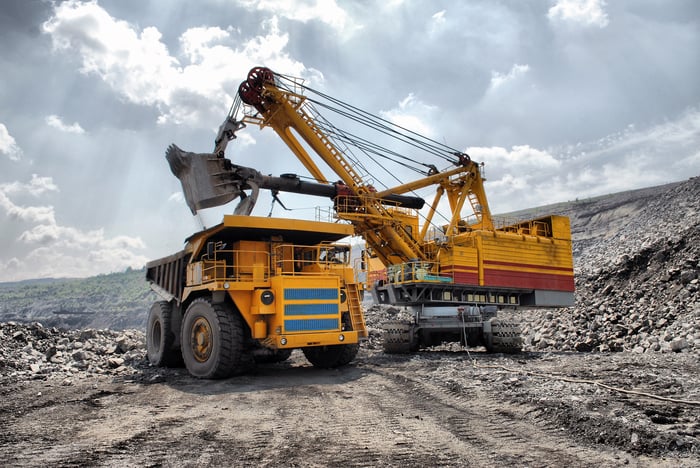This article was updated on August 4, 2017, and originally published on March, 31, 2017.
Though it's been a wild ride for precious-metal mining stocks over the past couple of years, the tide has most definitely shifted toward bullishness since the beginning of 2016. Even after a sizable pullback in gold and silver stocks since they hit their highs last summer, these two industries have been among the market's top performers over the past six quarters.
What's behind the surge in gold and silver stocks
Higher underlying spot prices for gold and silver are one obvious reason for higher valuations in gold and silver mining stocks. Even after four interest rate hikes from the Federal Reserve since Dec. 2015, the opportunity cost of passing up interest-bearing assets, such as Treasury bonds and bank CDs, is still low enough to encourage investors to buy physical gold or silver. Metals don't pay dividends, meaning higher interest rates (and thus higher yields) can lure investment dollars away from them.

Image source: Getty Images.
Physical metals are also benefiting from a mountain of political uncertainty, even as the U.S. stock market is hitting new all-time highs. President Trump's unsuccessful attempts to replace Obamacare, and Britain's triggering of Article 50, signaling its intent to leave the European Union, are only two examples of issues that are making the future even less predictable, and driving investors to physical gold and silver.
However, credit should also be given to the gold and silver mining companies. Following a multiyear downtrend in precious-metal prices, gold and silver producers significantly reduced their capital expenditures and chose to focus on expanding or developing only their highest ore grade projects. In the process, these precious-metal miners substantially reduced their all-in sustaining costs (AISC), allowing them to be profitable at considerably lower spot prices.
An industry shift is under way, and this confirms it
However, there's another shift that's been under way among the precious-metal miners for quite some time. It's largely been happening under the radar, but is designed to lead to steadier growth and hopefully lower AISC over the long run: Miners are moving away from relying primarily on one metal (either gold or silver) for their revenues, and toward either a more balanced precious-metal portfolio, or one that focuses on a completely different metal than before.
Within a span of a week in March 2017, two precious-metal miners announced their intentions to change their names. First, Silver Wheaton proposed changing its name to Wheaton Precious Metals (NYSE: WPM) , and then not long thereafter Silver Standard Resources announced its intent to change its name to SSR Mining (Nasdaq: SSRM). Since the announcements, both name changes received the needed shareholder approval, and took effect in May and August, respectively.
Generally, company name changes are complete nonevents – but not this time: These companies renamed themselves to reflect their changing production portfolios.

Image source: Getty Images.
Wheaton Precious Metals, which is a streaming company that provides upfront cash to mining companies to develop or expand their mines in exchange for a percentage of the production at a low-fixed cost, used to be reliant on silver. Today, that's not the case. In the second half of 2016, its revenue was pretty evenly split between gold and silver, primarily thanks to the 213,600 ounces of gold production recognized from the Salobo mine in Brazil.
Likewise, SSR Mining, which is a traditional precious-metal mining company, has moved away silver and leaned heavily on gold. Its 2016 acquisition of Claude Resources will bring about 70,000 to 80,000 ounces of annual gold production into its portfolio via the Seabee mine. At the same time, its Pirquitas silver mine in Argentina is at the end of its life, meaning SSR Mining, at least for the remainder of 2017 and early 2018, will be heavily reliant on gold production from Marigold and Seabee. However, a new joint-venture in Argentina with Golden Arrow should allow SSR Mining to increase its silver production beginning in late 2018, albeit it'll still be reliant on gold for a majority of its revenue.
This isn't just limited to two companies
What's worth noting here is that while Wheaton Precious Metals and SSR Mining stand out for their shifting production profiles because of their name changes, they're hardly the only precious-metal miners seeing a shift in production.
As we examined a few months ago, the Bank of Montreal looked at 2017 production estimates for 11 silver miners recently and found that more than half of them (including SSR Mining) expect to generate 50% or more of their revenue from the sale of gold or base metals.

Image source: Getty Images.
For instance, Hecla Mining (HL) only brought its San Sebastian mine into commercial production last year. While it did produce nearly 4.3 million ounces of silver last year, it's also a gold-producing mine. Similarly, Casa Berardi is a big producer of the yellow metal for Hecla, and there are numerous expansion opportunities still to come with this mine. Hecla's gold, silver, and base metal production is about as balanced as it gets from a revenue perspective.
This ongoing and dynamic shift in production demonstrates that gold and silver miners are far more nimble than they've ever been. They're also arguably looking further into the future than they've ever done before. Rather than relying solely on current spot prices to drive their decisions, many are taking a diversified and/or hedged approach that lets them take advantage of gold during times of uncertainty, and silver during periods of economic expansion. (Silver has more practical uses than gold.)
All told, these shifts have this Fool believing that gold and silver mining companies are looking stronger than ever.




